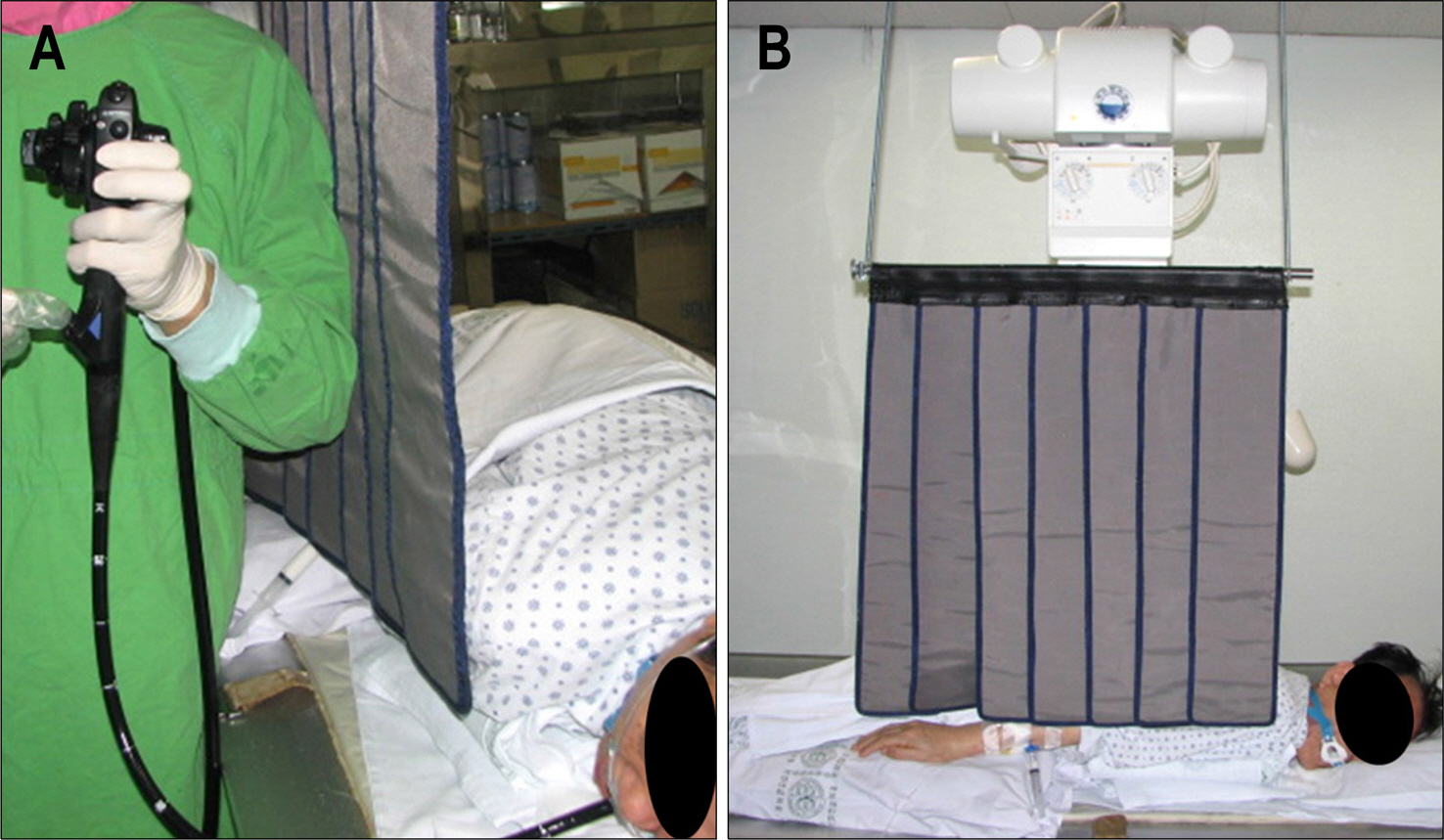Korean J Gastroenterol.
2011 Jan;57(1):28-33. 10.4166/kjg.2011.57.1.28.
Efficacy of a Self-designed Protective Lead Shield in Reduction of Radiation Exposure Dose During Endoscopic Retrograde Cholangiopancreatography
- Affiliations
-
- 1Department of Internal Medicine, Keimyung University School of Medicine, Daegu, Korea. chokb@dsmc.or.kr
- KMID: 991465
- DOI: http://doi.org/10.4166/kjg.2011.57.1.28
Abstract
- BACKGROUND/AIMS
The increasing use of diagnostic and therapeutic endoscopic retrograde cholangiopancreatography (ERCP) calls for greater consideration of radiation exposure risk to endoscopists and assistants, and emphasizes the proper system of radiation protection. This study was designed to assess the effect of a newly developed, self-designed, protective lead shield.
METHODS
A curtain-shaped protective shield composed of seven movable lead plates was developed, each with the following dimensions: depth, 0.1 cm; width, 15 cm; length, 70 cm. The curtain-shaped protective shield was designed to be located between the patient and the endoscopist. Twenty-nine patients (11 men and 18 women) undergoing ERCP between January 2010 and March 2010 were selected for this study. The dose of radiation exposure was recorded with or without the protective lead shield at the level of the head, chest, and pelvis. The measurement was made at 50 cm and 150 cm from the radiation source.
RESULTS
The mean patient age was 64 years. The mean patient height and weight was 161.7+/-6.9 cm and 58.9+/-9.9 kg, respectively. The mean body mass index (BMI) was 22.5+/-3.0 kg/m2. Endoscopists received 1522.2+/-537.0 mR/hr without the protective lead shield. At the same distance, radiation exposure was significantly reduced to 68.8+/-88.0 mR/hr with the protective lead shield (p-value<0.0001). The radiation exposure to endoscopists and assistants was significantly reduced by the use of a protective lead shield (p value<0.0001). The amount of radiation exposure during ERCP was related to the patient's BMI (r=0.749, p=0.001).
CONCLUSIONS
This self-designed, protective lead shield is effective in protecting endoscopists and assistants from radiation exposure.
Keyword
MeSH Terms
Figure
Cited by 1 articles
-
Lack of Radiation Protection for Endoscopists Performing Endoscopic Retrograde Cholangiopancreatography
Byoung Kwan Son, Kyu Taek Lee, Jae Seon Kim, Seung Ok Lee
Korean J Gastroenterol. 2011;58(2):93-99. doi: 10.4166/kjg.2011.58.2.93.
Reference
-
References
1. Selmaier M, Stillkrieg W, Müller RG, Hahn EG, Ell C. Radiation burden in diagnostic and therapeutic endoscopic retrograde cholangiopancreatography (ERCP). Z Gastroenterol. 1994; 32:671–674.2. Peters PE, Katz G, Safrany L, Weitemeyer R. Radiation exposure in patients undergoing endoscopic retrograde cholangiopancreatography and endoscopic papillotomy. Gastrointest Radiol. 1978; 3:353–355.
Article3. Wagner RH, Boles MA, Henkin RE. Treatment of radiation exposure and contamination. Radiographics. 1994; 14:387–396.
Article4. Cohen RV, Aldred MA, Paes WS, et al. How safe is ERCP to the endoscopiest? Surg Endosc. 1997; 11:615–617.5. Strzelczyk JJ, Damilakis J, Marx MV, Macura KJ. Facts and controversies about radiation exposure, part 1: controlling unnecessary radiation exposures. J Am Coll Radiol. 2006; 3:924–931.
Article6. Campbell N, Sparrow K, Fortier M, Ponich T. Practical radiation safety and protection for the endoscopist during ERCP. Gastrointest Endosc. 2002; 55:552–557.
Article7. International Commission on Radiological Protection. 1990 recommendations of the International Commission on Radiological Protection: adopted by the Commission in November 1990. 1st ed.Oxford: Pergamon;1991.8. Larkin CJ, Workman A, Wright RE, Tham TC. Radiation doses to patients during ERCP. Gastrointest Endosc. 2001; 53:161–164.
Article9. Kimmey MB, AI-Kawas FH, Burnett DA, Carr-Locke DL, Gannan RM, Saeed ZA. Radiation safety during endoscopy. Gastrointest Endosc. 1994; 40:801–804.10. Johlin FC, Pelsang RE, Greenleaf M. Phantom study to determine radiation exposure to medical personnel involved in ERCP fluoroscopy and its reduction through equipment and behavior modifications. Am J Gastroenterol. 2002; 97:893–897.
Article11. Heyd RL, Kopecky KK, Sherman S, Lehman GA, Stockberger SM. Radiation exposure to patients and personnel during interventional ERCP at a teaching institution. Gastrointest Endosc. 1996; 44:287–292.
Article12. Chen MY, Van Swearingen FL, Mitchell R, Ott DJ. Radiation exposure during ERCP: effect of a protective shield. Gastrointest Endosc. 1996; 43:1–5.
Article13. Uradomo LT, Goldberg EM, Darwin PE. Time-limited fluoroscopy to reduce radiation exposure during ERCP: a prospective randomized trial. Gastrointest Endosc. 2007; 66:84–89.
Article
- Full Text Links
- Actions
-
Cited
- CITED
-
- Close
- Share
- Similar articles
-
- Lack of Radiation Protection for Endoscopists Performing Endoscopic Retrograde Cholangiopancreatography
- Minimizing radiation exposure in endoscopic retrograde cholangiopancreatography: a review for medical personnel
- A Survey of the Radiation Exposure Protection of Health Care Providers during Endoscopic Retrograde Cholangiopancreatography in Korea
- Endoscopic retrograde cholangiopancreatography complications: Techniques to reduce risk and management strategies
- The reduction methods of operator's radiation dose for portable dental X-ray machines



